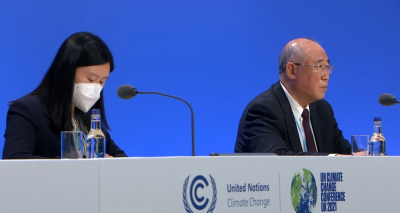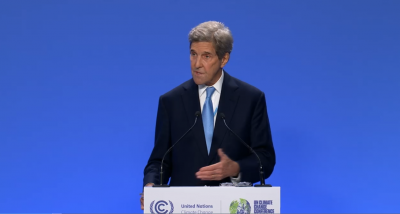Making Sense of the US-China Joint Glasgow Declaration
One small step for climate action, one modest leap for US-China relations
Yesterday, China and the US announced a “Joint Glasgow Declaration on Enhancing Climate Action in the 2020s” (En/Ch) What to make of it? The short answer is that it only offers slight forward progress on climate action. Increased climate ambition from China and US in the short-term remains the critical metric and in this regard the agreement does not make much of a breakthrough. It embodies mostly potential. But the very fact that the two countries were willing to sign onto a high-profile joint declaration is a positive sign that rising geopolitical tensions have not made cooperation in areas of mutual interest impossible.

Climate Progress
As I discussed in my post last week, the critical question for COP26 is whether the nations of the world are moving with adequate speed toward the 1.5°C goal. Among other things, this means finding a way to nearly halve emissions within the next eight years. Action from the world’s two largest emitters is obviously essential to achievement of this goal. China had been unusually quiet at COP26 and this declaration marks their most visible intervention at Glasgow.
The most significant piece of news from the joint declaration was paragraph 8 on methane. China did not sign onto the global methane pledge to reduce methane emissions 30% by 2030 from 2020 levels, but in the joint declaration announced an intention to “develop a comprehensive and ambitious National Action Plan on methane, aiming to achieve a significant effect on methane emissions control and reductions in the 2020s.” (My colleague Ted Parson explained in a post earlier this week why the fuss about methane is warranted). As with much of the Chinese climate program, more detail on interim targets, specific measures, and information about modeling and assumptions would help the world better understand the significance of this move. Much of this is work to come presumably, but I hope that China will commit to more extensive disclosure on the specifics.
The declaration otherwise just affirmed general principles, such as a common understanding that the world is not doing enough to achieve 1.5°C and that the two countries are committed to pursuing “enhanced climate actions that raise ambition in the 2020s in the context of the Paris Agreement.”
Other statements (e.g., that “China will phase down coal consumption during the 15th Five Year Plan and make best efforts to accelerate this work”) were affirmations of previous announcements. The declaration did not include any agreement from China to accelerate the date of its peak, nor did it offer any information about the level at which China would peak or the rate at which it would reduce emissions after a peak.
Again, the critical point is whether the US and China can take sufficient action on climate at home, not (as one commentator noted) whether they hold hands as they are doing it. To put it another way, we now know the US and China are willing to hold hands, but we don’t know whether that will lead to anything of substance.

Cooperation
That said, the declaration was an important break from rising US-China tensions, and it’s worth seeing whether this “agreement to hold more meetings” (as Georgetown’s Joanna Lewis put it) can help to accelerate US & China domestic climate action. The newly established “Working Group on Enhancing Climate Action in the 2020s” will provide a forum for information sharing and each future meeting and collaboration will be an opportunity to learn more about each country’s progress on critical areas of climate policy – clean energy transition, electrification, carbon capture, methane reduction, and so on. That can’t hurt.
Chinese leaders and advisors have insisted that the country’s climate program is simply misunderstood (see here and here). These US-China meetings will be an occasion for China to explain and make its climate action more legible to the world. Xie Zhenhua, China’s climate envoy, said at the press conference announcing the declaration that “in China, when we make a commitment, we take real action and honor our commitment.” These working group meetings are an opportunity for China to demonstrate that this is so. And it presents further opportunity to seek greater ambition through the cooperation.
Given the parlous state of US-China relations, it’s perhaps no surprise that Xie and Kerry did not exactly stand on the global stage together to make a joint announcement. The agreement was apparently to post the joint declaration simultaneously in English and Chinese to official websites, and to hold consecutive press conferences (Xie first). But in a period where US-China tensions are high, even this modest cooperation seems like a positive step.
In future posts, I plan to begin unpacking the specific climate policy documents that China has presented on the global stage.
Reader Comments
2 Replies to “Making Sense of the US-China Joint Glasgow Declaration”
Comments are closed.








China is the world’s largest emitter of greenhouse gases (approx. 30% last year) and far exceeds all of the developed nations combined (US approx. 11%, EU approx. 6.4%, India approx. 6.6%). This means that unless China makes drastic and timely cuts in its GHG emissions, reductions by the rest of the world will be insufficient to avoid catastrophic climate change.
However, last year, China put 38.4 gigawatts of new coal-fired power capacity into operation (more than three times the rest of the world) and several provinces, including Zhejiang, Anhui and Shandong, failed to meet China’s 13th Five-Year-Plan coal consumption reduction targets. Moreover China’s overall coal consumption targets were not set under its 14th Five-Year Plan (2021-2025) and were not presented at COP26.
This means that other nations must plan to enforce reductions in China’s GHG emissions as necessary. Nobel Laureate William Nordhaus has proposed a “Climate Club” involving carbon taxes or tariffs on products from countries that do not meet the Club’s goals.
The European Union is forming such a “Club” and is currently preparing to adopt a “border adjustment mechanism” that will avoid “carbon leakage” from countries that do not meet its goals. Additionally, the Biden administration is planning to include climate action in its trading policies as well.
If China continues its failure to meet its global responsibilities on its own, then it will be necessary for other nations to impose enforcement measures.
This is extremely great piece of journal regarding measures to contain climate change, as an evironmental and energy Law Scholar., I wholeheartedly support clean energy and good environmental justice